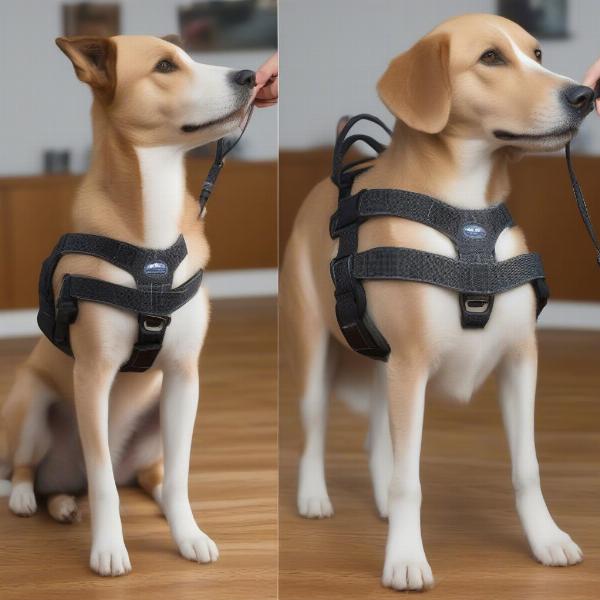A dog harness for pulling is more than just a piece of equipment; it’s an investment in your dog’s comfort and safety, especially if they love to pull or you participate in activities like canicross, bikejoring, or weight pulling. Selecting the right harness can make a world of difference, ensuring your furry friend can enjoy these activities without strain or injury. This article will guide you through the different types of pulling harnesses, factors to consider when choosing one, and tips for a comfortable and secure fit.
There are several types of harnesses designed specifically for pulling. The X-back harness, while common for everyday walks, isn’t ideal for pulling as it can restrict shoulder movement and potentially cause chafing. Y-front harnesses offer more freedom of movement and are a good choice for light pulling activities. For more serious pulling sports like weight pulling or mushing, a dedicated weight-pulling harness is essential. These harnesses are designed to distribute the load evenly across the dog’s body, minimizing strain and maximizing power.
Understanding Your Dog’s Pulling Needs
When choosing a dog harness for pulling, consider the type of pulling activity, your dog’s size and breed, and their individual pulling style. A small dog pulling a light cart will have different harness requirements than a large, powerful breed engaged in weight pulling.
 Properly Fitting a Dog Pulling Harness
Properly Fitting a Dog Pulling Harness
Is your dog a casual puller who enjoys a brisk walk or a dedicated athlete participating in competitive pulling sports? dog pulling cart and harness This will help determine the appropriate harness type and features. For instance, a harness with padded straps and breathable material is ideal for long-distance pulling.
Key Features to Look For
What features should you look for in a pulling harness? Durability is key, as the harness needs to withstand the forces of pulling. Adjustable straps are crucial for a customized fit, ensuring the harness is snug but not restrictive. Look for harnesses made from breathable materials to prevent overheating and chafing, especially during strenuous activity. Reflective elements are also important for visibility, especially if you’re pulling in low-light conditions.
How to Ensure a Proper Fit
A properly fitted harness is essential for your dog’s comfort and safety. The harness should fit snugly but not be too tight. You should be able to fit two fingers between the harness and your dog’s body. The harness should not restrict your dog’s movement or chafe their skin. dog pulling on harness Regularly check the fit of the harness, especially as your dog grows or changes weight.
Training and Safety Tips for Pulling
Introducing your dog to pulling should be done gradually. Start with short sessions and gradually increase the duration and intensity of the activity. Always use positive reinforcement methods to encourage your dog and make the experience enjoyable.
Never force your dog to pull if they are showing signs of discomfort or fatigue. Ensure they are properly hydrated, especially during warmer weather. A pulling harness can empower your dog to enjoy activities they love while keeping them safe and comfortable. dog pulling harnesses Choosing the right harness and following proper training techniques will ensure a positive and rewarding experience for both you and your furry friend.
Conclusion
Choosing the right dog harness for pulling involves considering your dog’s individual needs, the type of pulling activity, and key features like durability, adjustability, and breathability. A proper fit is essential for comfort and safety. With the right harness and gradual training, pulling activities can be a fun and enriching experience for both you and your canine companion. dog harness to stop pulling Remember to prioritize your dog’s well-being and ensure they are enjoying the activity.
FAQ
- What is the best type of harness for weight pulling? A dedicated weight-pulling harness is designed to distribute weight evenly and minimize strain during heavy pulling.
- Can I use a regular harness for pulling? While some harnesses can handle light pulling, a dedicated pulling harness is recommended for regular or intense pulling activities.
- How do I know if my dog’s harness fits correctly? You should be able to fit two fingers between the harness and your dog’s body. The harness should be snug but not restrict movement.
- How do I introduce my dog to pulling? Start with short sessions and gradually increase the duration and intensity. Use positive reinforcement and ensure your dog is comfortable.
- What safety precautions should I take when dog pulling? Ensure proper hydration, monitor your dog for fatigue, and use reflective gear for visibility, especially in low-light conditions.
- Can any dog breed participate in pulling activities? Most breeds can enjoy pulling, but certain breeds are predisposed to excel in these activities. Consult with your veterinarian.
- Where can I find high-quality dog harnesses for pulling? Reputable pet stores and online retailers specializing in dog equipment often carry a variety of pulling harnesses.
ILM Dog is a leading online resource for dog owners worldwide, offering expert advice on all aspects of dog care, from breed selection and health to training, nutrition, and product recommendations. We are dedicated to providing practical and reliable information to help you provide the best possible care for your furry friend. dog weight pulling harness For further guidance on dog harnesses and other essential dog care topics, visit ILM Dog. Contact us at [email protected] or +44 20-3965-8624 for personalized assistance.